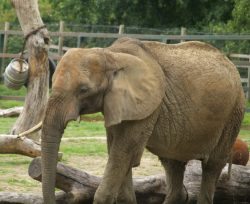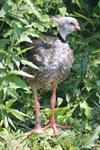
Train for a Professional Career working with Wild Animals
Take the next step beyond a certificate to a professional level course of training in wildlife management.
This course would be close to two years of full time study at most colleges; however, under our system you may fast track it or take it slow. Some may complete it in one year, while others may take many years to finish the course. If you wish to achieve career success in this industry, a substantial course (around 1500 hrs or more) together with experience (initially most would gain experience as a volunteer), is what is needed to optimise your opportunities.
To obtain the Associate Diploma, you are required to complete TEN core modules and five elective modules .The elective modules allow you to focus on the particular area of wildlife management that interests you.
Modules
Note that each module in the Qualification - Associate Diploma in Wildlife Management is a short course in its own right, and may be studied separately.
Managing Behaviour can be as Important as Managing Health

The wellbeing and sustainability of wildlife can be affected just as much by their behaviour as their general health.
Wildlife officers need to understand both behaviour and health in order to properly manage wild animals. This applies equally to animals in captivity, as to animals in the wild.
Social Behaviour
Social behaviour refers to how animals relate to others of their own kind. The main kinds of social group are:
- Colonial
- Eusocial
- Hierarchical
- Social
- Territorial
 Colonial Animals
Colonial Animals - live in large groups close to each other. The colonies may sometimes only exist at certain times of the year e.g. during the nesting season for some seabirds. Meerkats, however, will remain as a single social unit often beyond the lifetime of an individual member of the den.
Eusocial - mainly relates to species with a highly developed social structure, such as ants, termites and some wasps and bees. They will live in colonies with a strict caste system. Only the queen and her consorts can breed. The majority of offspring become workers and soldiers to gather food, protect the colony and raise the young. Workers are females and when a male is needed for mating, a juvenile is fed special food and becomes a male. On maturity, he goes on a nuptial flight with the new queen, mates and then dies.
Hierarchical Animals - have a pecking order. The animals at the top will be aggressive and dominate the lower ranks to retain access to food, safe places to sleep, mates, etc. This is known as the pecking order as it was shown clearly with fowls. Dairy cattle have a very definite “pecking order” of entering the bails to be milked and, when left to control it themselves, they will be entering in their own order. Males often dominate a pack, such as with gorillas and lions, but not always. The female spotted hyena outranks males.
Social Animals - tend to stay with their own species. To be defined as social though, the group must not just be a random collection of individuals, but they must cooperate with each other in some way, such as defending a territory, and recognise each other by sight and scent. This is very clearly seen with meerkats; they will eat, hunt and sleep together until one displeases the others, which is then forced to keep itself separate from the group, until it redeems itself and is accepted into the group again.

Territorial Animals - will defend an area in which they live and depend on for resources, such as food, mates, and so on. The animal must advertise its ownership of the territory, such as by the use of scent marking (e.g. cats, both domestic and wild), border disputes, and challenging others of their species who come nearby e.g. a koala will fight another koala in its feeding area to keep all the food for itself. To introduce another Koala is almost certain death - either directly from the area’s 'owner' (dominance) or by starvation, which will challenge others of the same species that dare to come nearby. If an animal does not advertise to other animals that it owns a particular territory, then the animal is not territorial.
Bird songs, for example, can be an advertisement to show that is the bird's territory and serve as a warning for all others to keep out. But of course, it is not just that simple, primates for example have a complex range of social structures.
Animal Ethics
Ethics comes from the Greek word ‘ethos’ meaning: custom, habit, character, moral nature. It might simply be described as the study of “how we should act and why”. Animal ethics is the branch of ethics that reflects on our moral decisions as to what is acceptable and unacceptable in our utilisation of animals. There are many aspects of “animal ethics” to consider when making moral decisions including the psychology and significance of animals’ minds; the moral status of animals and significance of different species; issues associated with animal products, farm animals, pets, zoos, hunting, animals for entertainment, safety testing on animals, and environmental ethics. Additional influences on our moral decisions on the use of animals also depends on what we have been taught, the viewpoints of our society or religion, customary traditions etc.
Moral Status of Animals
Humans use animals in such a large variety of ways that anyone with a conscience finds it difficult to make a self-evident decision on which uses of animals are acceptable and which are unacceptable. As a result, it is often difficult for people to deliver consistent, invariable moral views when it comes to animal ethics.
The philosophy of the moral standing of animals is complex but in simple terms it may be categorised into three generic groups: Indirect theories; direct but unequal theories and moral equality theories.
Indirect Theories
Indirect theories deny animals having moral status, or at best, the moral status of animals is deemed unequal to humans, given that they do not experience consciousness, rationality or autonomy. Under these theories, animals only remain unharmed if, by doing so, it causes harm to the morality of the person.
Direct but Unequal Theories
Direct but unequal theories give some regard to the moral status of animals based on the belief that the sentience of the animal deems it unacceptable to cause it direct harm. These theories do not offer equal moral consideration to animals and humans due to animals having the inability to respect others rights or show mutual respect; and due to their lack of “special human abilities” of self-consciousness, reason and autonomy.
Moral Equality Theories
Moral equality theories believe that animals should receive equal consideration and moral status as humans. These theories do not validate “special human abilities” as grounds for moral superiority. Furthermore, they extend their argument to consider the physiological and mental capacities of human babies and disabled people being similar to animals, thereby adding to the argument for equality.
